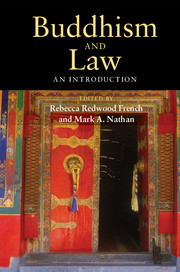Book contents
- Frontmatter
- Dedication
- Contents
- Maps and Illustrations
- Contributors
- Preface
- Abbreviations
- Introducing Buddhism and Law
- Part I The Roots of Buddhism and Law in India
- Part II Buddhism and Law in South and Southeast Asia
- Part III Buddhism and Law in East Asia
- Part IV Buddhism and Law in North Asia and the Himalayan Region
- 17 Buddhism and Law in Tibet
- 18 Buddhist Laws in Mongolia
- 19 Karma, Monastic Law, and Gender Justice
- 20 Buddhism and Constitutions in Bhutan
- A Selection of Readings
- Index
- References
18 - Buddhist Laws in Mongolia
Published online by Cambridge University Press: 05 August 2014
- Frontmatter
- Dedication
- Contents
- Maps and Illustrations
- Contributors
- Preface
- Abbreviations
- Introducing Buddhism and Law
- Part I The Roots of Buddhism and Law in India
- Part II Buddhism and Law in South and Southeast Asia
- Part III Buddhism and Law in East Asia
- Part IV Buddhism and Law in North Asia and the Himalayan Region
- 17 Buddhism and Law in Tibet
- 18 Buddhist Laws in Mongolia
- 19 Karma, Monastic Law, and Gender Justice
- 20 Buddhism and Constitutions in Bhutan
- A Selection of Readings
- Index
- References
Summary
Introduction
Examining the historical relationship between Buddhism and law in Mongolia helps us to understand several aspects of this pastoral society, namely, the Buddhist legal consciousness, the defining characteristics of both religious and secular Buddhist law, the relationship between Buddhism and the state, and the ways in which Buddhism, law, and local customs shaped each other in this society. It also reveals the interdependence that emerged at times between Buddhist monastic and state laws, which took diverse forms in different sociopolitical climates. This interdependence contributed to the diminishing of the boundaries between the two and enabled the Mongol and Manchu Qing rulers to institute Buddhist codes of law as Buddhist monarchs in Mongolia. This was most evident during the Bogd Khaan state when the attempt to make all members of society legally responsible for the conduct and moral condition of monks became a symbolic expression of the communal values of a Buddhist society. General disobedience of such law would result in disintegration of the Buddhist character of the Bogd Khaan’s state. On these grounds, the observance of the law was deemed to be one’s civil and religious duty.
Buddhist legal codes in Mongolia show the influence of the nomadic and pastoral culture on the Mongolian Buddhist legal tradition, as both Buddhist ethical norms and legal codes became equally conditioned by the social, economic, and political contexts that tied them together. The legal documents that will be discussed in this essay show that the history of socioeconomic development and the structure of the Mongolian Buddhist establishment can be fully understood only in light of the history and character of the Mongolian legal tradition and vice versa. The Buddhist legal tradition in Mongolia developed into a complex social phenomenon and represented an intricate aspect of the Mongolian Buddhist world from the late sixteenth until the early twentieth centuries.
- Type
- Chapter
- Information
- Buddhism and LawAn Introduction, pp. 319 - 333Publisher: Cambridge University PressPrint publication year: 2014
References
- 1
- Cited by



